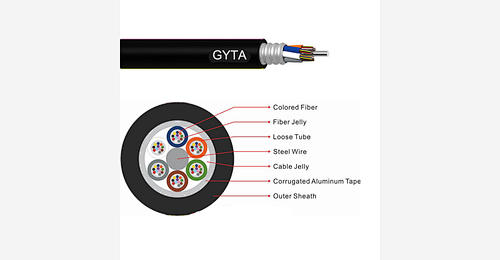Fiber optic cables can be categorized into two main types based on whether the optical fibers are loosely buffered or tightly buffered. These two designs serve different purposes depending on the intended environment of use. Loose tube designs are commonly used for outdoor applications, while tight buffer designs are typically used for indoor applications, like indoor breakout cables. Let's explore the differences between loose tube and tight buffer fiber optic cables.
Structural Differences
Loose Tube Fiber Optic Cable: Loose tube cables contain 250μm optical fibers that are placed within a high-modulus material that forms a loose tube. This tube is filled with gel to prevent moisture penetration. At the core of the cable, there is a metal (or non-metallic FRP) central strength member. The loose tube surrounds the central strength member and is twisted to form a circular cable core. An additional water-blocking material is introduced within the cable core. After longitudinal wrapping with a corrugated steel tape (APL) or a ripcord steel tape (PSP), the cable is extruded with a polyethylene (PE) jacket.
Tight Buffer Fiber Optic Cable: Indoor breakout cables use a single-core optical fiber with a diameter of φ2.0mm (including φ900μm tight-buffered fiber and aramid yarn for added strength). The cable cores are twisted around an FRP central strength member to form the cable core, and finally, an outer layer of polyvinyl chloride (PVC) or low smoke zero halogen (LSZH) is extruded as the jacket.
Protection
Loose Tube Fiber Optic Cable: The optical fibers in loose tube cables are placed within a gel-filled loose tube, which helps prevent fiber moisture in adverse, high-humidity environments where water or condensation might be an issue.
Tight Buffer Fiber Optic Cable: Tight buffer cables offer double protection for optical fibers, with both a 250μm coating and a 900μm tight buffer layer.
Applications
Loose Tube Fiber Optic Cable: Loose tube cables are used in outdoor aerial, duct, and direct burial applications. They are common in telecommunications, campus backbones, short-distance runs, data centers, CATV, broadcasting, computer network systems, user network systems, and 10G, 40G, and 100Gbps Ethernet.
Tight Buffer Fiber Optic Cable: Tight buffer cables are suitable for indoor applications, data centers, backbone networks, horizontal cabling, patch cords, equipment cables, LAN, WAN, storage area networks (SAN), indoor long horizontal or vertical cabling.
Comparison
Tight buffer fiber optic cables are more expensive than loose tube cables because they use more materials in the cable structure. Due to the differences between 900μm optical fibers and 250μm optical fibers, tight buffer cables can accommodate fewer optical fibers of the same diameter.
Moreover, tight buffer cables are easier to install compared to loose tube cables since there is no need to deal with gel filling, and no branch closures are required for splicing or terminating.
Conclusion
Loose tube cables offer stable and reliable optical transmission performance over a wide temperature range, provide optimal protection for optical fibers under high tensile loads, and can easily resist moisture with water-blocking gels. Tight buffer cables provide high reliability, versatility, and flexibility. They have a smaller size and are easy to install.

Post time: Oct-24-2023

